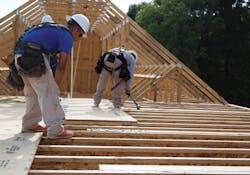8 Strategies to Help Ease the Labor Crunch
It’s no secret to anyone in the construction industry that the labor market is a challenge. At the end of last year, availability of labor was the top concern of builders for 2018, according to the NAHB/Wells Fargo Housing Market Index, with 84% of respondents anticipating issues.
Another NAHB survey, released this September, found that carpentry and framing are experiencing the tightest supplies of labor for both direct employment and subcontractors. A whopping 90% of builders are reporting shortages of rough carpentry subcontractors and 89% say framing subs are in short supply.
“The widespread shortages continue to restrain the pace of construction, further driving up construction costs, which are increasingly being absorbed by the home buyer,” the NAHB said. “The shortages are also affecting builders’ bottom lines by causing lost or canceled sales and making some projects unprofitable.”
The labor crisis stems from a variety of factors. For one, the industry continues to feel the effects of the housing bust, during which many workers departed for other industries. The aging workforce is another issue, says Tony Mancini, group director and principal at SGC Horizon, publisher of Professional Builder. “It’s not just a lack of people coming in, but over the next 10 years many older people leaving the industry is going to be a big problem.”
Here are a few ways you can address the labor shortage within your own company and for the industry as a whole:
Change the narrative
Another reason for the slow flow of new talent is the fact that construction careers haven’t been as attractive to young people (and their parents). Many high schoolers simply don’t know about or understand the potential of a career in construction, automatically opting for college even if it may not be the best fit for them.
“Three percent of people want to be in construction,” Mancini says. “So positioning construction as a career rather than a job is something that’s going to be important for the overall industry.” The industry needs to highlight the positives of a career in construction, he notes, including the earning potential and the clear career path that can lead all the way to business ownership.
“[We need to] change the mindset of teachers and guidance counselors and parents,” adds Nancy Kelly, president and owner of Labor Masters, a staffing services firm in Fargo, N.D. “It’s OK not to get a four-year degree; it’s OK to get a certificate or a two-year degree.”
Connect with schools
Reach out to vo-tech teachers and trade schools as a way to connect directly with students and spread the message about construction careers. Volunteer for career day, ask about promising students for apprenticeship positions, perhaps even invite classes to observe life on the jobsite. “Talk to kids about what you do,” Kelly says. “We really need people to get involved at the grassroots level … if you don’t go in and tell people what you do, how will they know?”
Get involved with local associations
Word of mouth is one of the best ways to recruit. By remaining active with your local home builders association, you increase your chances of meeting potential new employees while demonstrating your company’s leadership. It also ensures you have a say in how the industry is addressing labor challenges at the local level.
Nurture newcomers
Entrepreneurial builders are putting apprenticeship programs together themselves and through their companies, according to Mancini.
Connect with veterans' groups
Veterans entering civilian life often bring a commitment to discipline, fluency in teamwork, and leadership skills, notes Rikka Brandon, founder and chief executive recruiter for Building Gurus, an executive search firm in the building products industry. Many also may have skills ideal for construction, such as a CDL license or familiarity with heavy equipment or power tools. “Seek out an organization in your area with a proven track record for placing vets into the workforce,” Brandon advises.
Think outside the box
Brandon also suggests deepening your pool by seeking out groups that are often overlooked, such as immigrants, individuals with disabilities, and stay-at-home parents. In many cases, these individuals not only have the necessary skills but also hardworking attitudes and appreciation for being given the opportunity.
Consider a temping or day labor service
Companies like Nancy’s provide as-needed general labor for builders for days, weeks, or months. The agency shoulders the burden of finding and screening labor, providing a match specific to your needs.
Support industry efforts
Several organizations within the industry are working toward addressing the labor shortage. For example, the Skilled Labor Fund is raising money to fund training in local markets; the group will be hosting a fundraiser at the Builders’ Show in February. Fine Homebuilding magazine launched the #KeepCraftAlive initiative, designed to showcase the unique stories of craftspeople as a means to attract newcomers while raising money for scholarships.
Along with these recruitment strategies, another consideration is to ease the burden on existing crews and subs by specifying products that are easier to install. For example, LP Legacy® premium sub-flooring is delivered working-side up, features pre-printed fastener marks, and has an easy-fit, self-gapping tongue-and-groove to simplify installation, particularly for those new to framing. In addition, Legacy’s superior moisture resistance prevents edge swell and comes with a Covered Until It’s Covered™ no-sand guarantee, further saving time and helping to ease the labor burden.
For more information, visit www.lpcorp.com/legacy.


